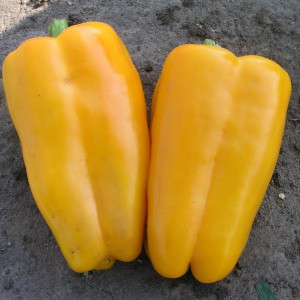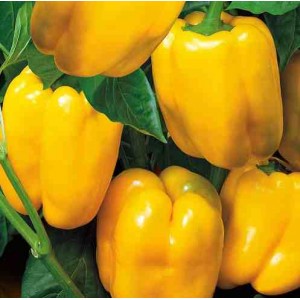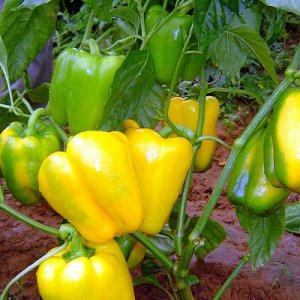Dutch hybrid pepper "Gemini f1": reviews of farmers with experience and rules for caring for it
Pepper is a vegetable that can pleasantly surprise you with its taste and useful properties. A bright representative of the new generation of selection - Bell pepper Gemini f1. Holland is considered a leader in the production of plant hybrids for a reason. The crops bred by the breeders of this country have always attracted gardeners. Dutch hybrids are distinguished by their special stress resistance, excellent taste and high yield. Gemini pepper has all these qualities. Therefore, many gardeners choose it for growing on their site.
The content of the article
What is this pepper

Translation of the word Gemini from English means "Gemini"... The plant probably got its name due to the high similarity in the appearance of the fruits - all peppers are the same, like twin brothers.
The Bayer company is engaged in the release of plant seeds. The agrofirm holds a leading position in the markets of many countries. Its products are chosen not only for private use, but also for cultivation on farms.
F1 hybrid
Gemini is a hybrid culture, that is, obtained by crossing the parental varieties. Packing with planting material always has the letter f1. To obtain the declared characteristics of the hybrid (yield, fruit size, taste) during cultivation, it is necessary to carefully follow the rules of agricultural technology.
At the end of the growing season, seeds from the fruit are not suitable for further cultivation, since they do not retain their genetics. Planting material will have to be purchased again, although the cost of hybrid seeds is quite high.
Characteristics and description of the variety
The Gemini f1 pepper bush is medium-sized, reaching a maximum height of 50 cm. The leaves are dark green. A large number of leaves are formed on the bush, which protect the fruits of the plant from sun exposure. It has a strong stem that can withstand the stress of heavy fruit.
It begins to bear the first fruits 3 months after planting the seedlings. An important feature is its resistance to the effects of all common diseases. About a dozen large fruits can be harvested from one plant.
Distinctive features
Gemini f1 is recognizable for its rich yellow fruit color, which is almost the same size and shape. The pepper does not have any critical shortcomings, the manufacturer claims high seed germination and a pleasant taste of the fruit.
Characteristics of fruits, yield

The fruits are bright yellow cubic in shape. Reach a mass of 200 g, if the growing place is open ground, and 300 g when cultivated on protected soils. The fruit walls do not exceed 8 mm, the peduncle is freely separated.
Peppers have a great taste with a little bitterness. Even if the crop was harvested before the onset of maturity and the fruits ripen in storage areas, they do not lose their excellent taste. You can use peppers for both conservationand fresh.
Preparation for growing
The soil used for seedlings should be light, contain the required amount of nutrients and have drainage properties. For cooking, use sand (1 part), humus (2 parts) and earth (1 part). All components are mixed.
Any shallow box or box that can hold soil and moisture is suitable as a container for seedlings. There is no need to process the seeds in any additional way, since they are already prepared by the manufacturer for planting. The planting material is germinated at a temperature of 22 to 27 ° C by soaking in a damp cloth or on a cotton pad.
Growing seedlings (with and without a pick)
Which way of growing pepper seedlings to choose - with or without a pick, each gardener decides for himself. To avoid transplanting, damaging the root system of plants, seeds are immediately sown in separate containers or peat tablets. If this is not possible, landing is made in a common box. Then, when real leaves appear, a pick is made into separate cups.
Planting pepper
The time of planting seedlings depends on the subsequent method of planting in the ground. At the end of January, seeds are sown for growing peppers in a greenhouse, in the first half of March - for cultivation in open ground. The soil must be pre-moistened before planting. No fertilization is required during sowing. It is important to observe a planting depth of no more than 2 cm. At a greater depth, seedlings will be late, and the plants themselves will be depleted.
Further care
After sowing, they provide optimal soil and air moisture, maintain the required temperature regime. Water the seedlings only with warm water. If all the conditions for planting and caring for plants are met, the seeds will sprout after 14 days.
With the appearance of the first shoots, the temperature is maintained at no more than +24 ° C and the seedlings are provided with constant lighting. Daylight hours should be at least 12 hours. If this condition is not observed, then the bushes will stretch and deform.
By the time the first two true leaves are formed, seedlings are fertilized with mineral fertilizers. Ammonium nitrate, superphosphate and potassium fertilizers diluted in water are used. It is required to repeat the feeding procedure 14 days after the first, the amount of fertilizer applied is doubled.
You can start planting seedlings in a greenhouse or open ground after 50 days. It is important to harden. To do this, it is necessary to accustom the peppers to a lower temperature, sun and winds, taking the seedlings outside. By the time of planting in the ground, at least 5 leaves should have formed on each bush. An important condition is that the soil warms up to at least +13 ° C, otherwise the plant's root system may die.
Features of growing varieties and possible difficulties
Growing a Gemini f1 hybrid requires frequent watering of the soil, undercut loosening and top dressing. Another imperative is mulching, which helps protect the roots from temperature changes and retains moisture in the soil.
Top dressing is carried out 3 times:
- 7 days after planting in the ground;
- when the plant blooms;
- when the fruits begin to form.
As a fertilizer, it is enough to use a top dressing containing phosphorus and potassium. Fertilizers with chlorine cannot be used - the hybrid does not like such fertilizers.
The formation of a bush is carried out in one stem. All emerging shoots are removed. The first flower that appears is cut off, this will allow the plant to form more friendly ovaries in the future.
Attention! Since the fruits of the hybrid are heavy, tying the bushes to the support is required.
Typical diseases and pests
Gemini pepper f1 is resistant to diseases and pests. But under unfavorable growing conditions, the plant can suffer from diseases and insects.
Chances are high to face exposure:
- whitefly;
- spider mite;
- slugs;
- aphids.
From insects use garlic and onion infusions, manual collection and, in extreme cases, chemical remedies.
Pepper is susceptible to diseases such as:
- anthracnose;
- spotted wilting;
- fusarium wilting;
- top rot;
- white rot;
- gray rot;
- blackleg;
- late blight;
- black spot;
- cladosporiosis.
All known diseases of peppers can be divided into several types: simple, complex, fungal and viral.
To avoid infection, it is important to carry out prevention:
- avoid waterlogging of the soil;
- avoid sudden changes in temperature if the plant is grown in a greenhouse;
- be sure to feed;
- a plant that has been affected by a disease, remove and destroy;
- for planting, do not use areas where infected plants were previously found.
Many pepper diseases cannot be cured, so prevention rather than cure is the best option.
Advantages and disadvantages of the variety
Like any culture, the f1 Gemini has its advantages and disadvantages.
Let's list the pros:
- the hybrid is early ripe, while the fruits ripen at about the same time;
- the fruits are large, have an attractive presentation;
- great taste that remains unchanged, regardless of whether the fruit ripened on a bush or ripened after harvest;
- well protected from the effects of viral diseases;
- a rich harvest from each bush;
- versatility in the use of fruits.
Disadvantages:
- due to the large number of large-sized fruits, the bush needs support;
- it is imperative to feed, otherwise the thickness of the fruit wall decreases.
Reviews
Summer residents emit high seed germination, bright taste and color of fruits. As a rule, there is no negative attitude towards this variety.
Irina, Taman: “I have been growing Gemini f1 for several years with great pleasure. The seeds sprout amicably, in the open field the plant gives a lot of fruits. I use it for fresh salads, yellow peppers in winter preparations look beautiful. "
Alevtina, Syzran: “I used to mistrust the seeds of hybrids. But I decided to try Gemini pepper f1. I tried to follow all the rules of cultivation: fed, did not allow waterlogging, did mulching. Imagine my surprise when, almost simultaneously, bright, beautiful peppers ripened, all as if on selection, the same. I advise everyone to grow this pepper now. "
Mikhail, Oryol: “Farmers know that hybrid seeds are great for growing high-volume vegetables for sale. So Gemini pepper f1 showed its best side. Of course, it requires care: you need top dressing, regular watering and a bush garter. But the result is worth it - the bright yellow beautiful fruits do not linger on the counter. "
Read also:
Very bright and surprisingly tasty Chanterelle pepper.
What are the health benefits of cayenne pepper and how to grow it properly.
Conclusion
Gemini pepper f1 is popular with both amateur gardeners and professional farmers. Proper cultivation will definitely reward a bountiful harvest. It is only important to follow the simple rules of cultivation: feed on time and regularly water the bed with sweet pepper.
After the stage of technical maturity, the peppers keep well for two to three weeks, which is convenient for transportation. Excellent taste, resistance to major diseases and amicable ripening of fruits allow this hybrid to be a frequent visitor to garden plots. Try growing Gemini peppers and the vibrant yellow twin peppers will brighten up any salad or winter preparation.